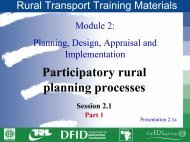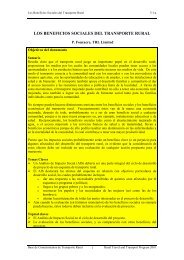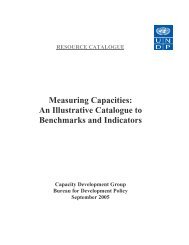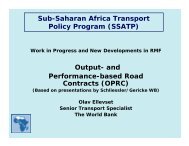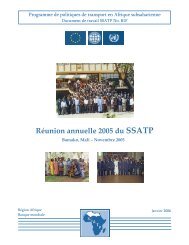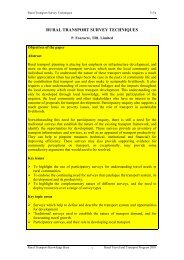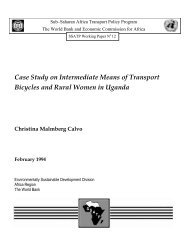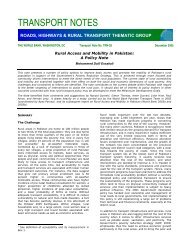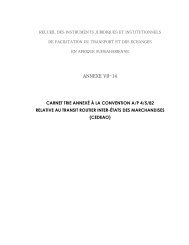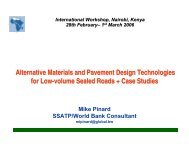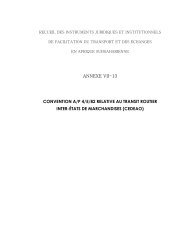Urban Transport - World Bank
Urban Transport - World Bank
Urban Transport - World Bank
Create successful ePaper yourself
Turn your PDF publications into a flip-book with our unique Google optimized e-Paper software.
With respect to leadership competence in urban transport planning, several workshop<br />
participants highlighted the need to ensure that political leaders develop an understanding of the<br />
kinds of longer term issues associated with urban transport that transcend the short time frame of<br />
the political cycle. To be sure, political leaders will continue to make many decisions that reflect<br />
immediate political expediency, but efforts should be made to try to ensure an understanding of<br />
longer-term issues. One suggested option to pursue this would be to use the SSATP network to<br />
deliver CD in this area under the <strong>World</strong> <strong>Bank</strong>'s Leaders in <strong>Urban</strong> <strong>Transport</strong> Program.<br />
With respect to advocacy and awareness building, participants highlighted that such efforts<br />
would need to be addressed at many different levels of government, including local, national,<br />
and, indeed, international levels. Little capacity exists in these areas currently and the<br />
participants emphasized that capacity building is important to create a practical mass of<br />
practitioners which can carry out the advocacy work. At the local level, one participant<br />
highlighted six key areas for advocacy intervention:<br />
a) Understanding the role of public transport in shaping cities. This was suggested<br />
specifically in the context of addressing the powerful car lobby which often works at<br />
cross purposes of the objective of expanding public transport extent and services.<br />
b) Understanding key stakeholders better, particularly the taxi / paratransit sector.<br />
c) Doing better assessment of the impact of public transport interventions, particularly in<br />
terms of environmental and social impacts. Indeed, several participants highlighted the<br />
need to be able to better articulate for policy makers the link between public transport<br />
provision and poverty alleviation.<br />
d) Doing better alternatives analysis of transportation options when investments are<br />
contemplated, in order to have a clear picture of the lifecycle cost implications of<br />
different interventions.<br />
e) Provide assistance to technical staff in governments at different levels on how to address<br />
unsolicited proposals which can often capture the attention and imagination of political<br />
decision makers. Examples of unsolicited proposals can include a proposed real estate<br />
development around a highway that is not consistent with current land-use regulations, a<br />
proposal to use a particular fuel or vehicle propulsion technology not based on any<br />
established performance standard, or even an unexpected proposal to develop a particular<br />
mode of transport along a particular corridor.<br />
f) Understanding the linkage between urban transport and other issues related to urban<br />
growth and development, such as land-use planning. Several participants highlighted the<br />
need to understand why better coordination between transport and land-use was not being<br />
carried out in Sub-Saharan Africa.<br />
At national and continental levels, it was felt that there is little recognition of sustainable urban<br />
development and sustainable transport policy as a policy agenda item worthy of high-level<br />
consideration at par with other development agenda topics such as agriculture, energy<br />
development, natural resource use and protection, etc. Participants highlighted the potential role<br />
that SSATP and the Environmentally Sustainable <strong>Transport</strong> Forum for Africa (EST-Africa)<br />
could play in helping to highlight the importance of sustainable urban transport to high level<br />
policy makers.<br />
6







